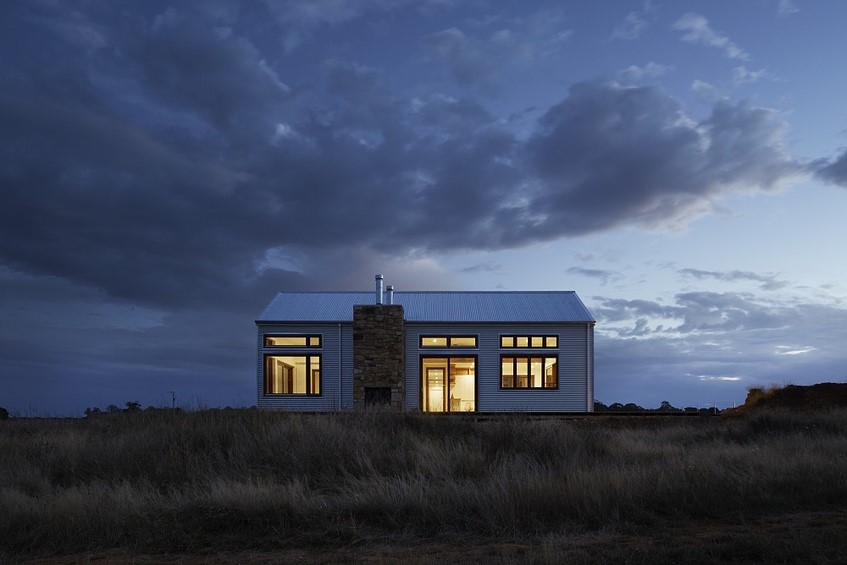
The climate of the local area and the positioning of a home will affect its overall energy star rating. Image: Peter Clarke
Give me a home among the gum trees. Or high rises. Or the suburbs. Give me a metal roof, some brick veneer walls and a concrete floor. That’ll put me on par with the average newly-constructed home in Australia. It seems that that’s where our tastes lie, but how energy efficient are these features?
Around 11.4% of Australia’s emissions can be attributed to households, and with construction continuing at a steady pace, it’s important that we keep an eye on our energy efficiency efforts. We’ve launched the Australian Housing Data (AHD) Portal to do just that and, as always, the truth is in the data.
All the stars
Energy star ratings for homes were introduced in 2001. It’s a scale of 1-10 stars, describing the ‘thermal performance’ of a home – that is, how much heating or cooling is required to make it comfortable. Star ratings are based on information about the home’s design, construction materials and where it’s built. For example, if your home capitalises on local breezes and is positioned to maximise the sun’s path, it may have a higher star rating. But a traditional breezy ‘Queenslander’-style home built in a cooler climate may be rated lower. It’s all about staying comfortable and using less energy when temperature extremes are upon us.
Back in ’01, the energy efficiency of the average home was 1.8 stars. Here’s a progress snapshot of just how far we’ve come since then:
| Houses | Apartments | |||
| State | Star rating | Size (m2) | Star rating | Size (m2) |
| ACT | 6.9 | 141 | 7.4 | 75 |
| NSW | 5.9 | 146 | 6.3 | 77 |
| NT | 6.3 | 117 | 7.7 | 61 |
| QLD | 6.4 | 125 | 6.1 | 82 |
| SA | 6.3 | 134 | 6.4 | 69 |
| TAS | 6.5 | 117 | 7 | 92 |
| VIC | 6.2 | 155 | 6.8 | 61 |
| WA | 6.1 | 148 | 6.8 | 75 |
| National | 6.2 | 144 | 6.4 | 75 |
We can see that the average newly-constructed home in 2018-19 had an energy rating of 6.2 stars. If we compare it to the 2001 average of 1.8 stars, this translates to an annual saving of approximately $560 in energy bills and 2.3 tonnes of CO2 equivalent (tCO2-e) in greenhouse emissions per house. Great news for both the hip pocket and the environment.
Kudos is due to the ACT and Tasmania, with both houses and apartments falling well above the national star rating average. The data also shows that Victoria and the Northern Territory are building very efficient apartments, although they are among the smallest in overall size (and built in fewer numbers in the NT).
While star ratings give an overall efficiency rating for our homes, they’re limited to the building itself – not appliance use.
There are a number of other measures that can be taken to ensure we stay comfortable throughout the seasons. Energy consumption by hot water systems, lights or household appliances is not considered in the rating because these fittings are usually replaced several times during the life of the building. We’ve put together some suggestions on staying warm in winter and cool in summer.

Energy star ratings determine the ‘thermal comfort’ of your home, which is the amount of heating or cooling required to achieve your preferred temperature.
Data-driven dreams
In addition to overall energy rating information, our AHD Portal information can be further broken down by design (e.g. dwelling class and floor area), construction (e.g. type of walls and roofing) and fixtures (e.g. solar PV and heating/cooling systems). Another interesting tidbit is that our homes are gradually increasing in size, which may spell the difference if you’re deciding between a 55 or 65” flat screen (the most energy efficient model, of course).
Our Grids and Energy Efficiency Research Director Dr Stephen White said the data shows steady progress in residential sustainability efforts.
“In order to meet national challenges of sustainable energy and resilient cities, it’s vital that we track progress. It’s an important step to ensure emissions goals are met, while seeing where more attention is needed across the industry,” Stephen said.
We’ll update dashboards in the AHD Portal frequently, ensuring it is a relevant and accessible tool for the benefit of residential energy efficiency stakeholders across the country.


15th September 2019 at 11:58 am
I bought a stone cottage built in 1884, and discovered after living in it for a while, that in its original form it was a very good passive solar house. Blind wall or narrow windows on the sunny side, access corridor running down the blind wall side, oriole and white arch on the western side (the parlour, or front room,with the best light of the whole house) and random rubble stone walls with a dressed stone front. Later owners ‘improved’ it by punching two standard windows into the blind wall and taking out the wall to make a lounge room the width of the house. Sun-proof curtains on that side, with holland blinds as well, made it manageable. Originally there were three coal grates, but the only operating one in 1975 was in the lounge room. I scavenged roadside wood all summer and had a fire all winter, never paid for a load of wood in 25 years. Added solar hot water in the early days before solar electricity panels were a thing.
17th May 2019 at 9:27 am
As we notice in summer, and as you point out in your “cool tips” page, one of or biggest energy users is air-conditioning for both homes and industry, especially retail. It seems intuitive to me find ways of avoiding the summer overheating of buildings in the first place – i.e. “an ounce of prevention is better than a ton of cure”. My research bought me to this CSIRO publication https://www.skycool.net.au/csiro from quite some time ago & I was wondering why this approach hasn’t been explored further.
16th May 2019 at 5:30 pm
I’d love to know how NatHERS compares against real-world energy usage. One of the challenges with one-size fits all simulation approaches is that you get a good result when averaged over hundreds to thousands of homes but the results for any one home may not be that reliable because of characteristics that are not captured in the model configuration.
I remember in the early naughties after we renovated our Canberra brick veneer home to be fully double glazed with more and bigger windows, well-insulated (250 mm polystyrene blocks and added extruded polystyrene insulation to the exterior of the brick veneer), more floor space, added raked ceilings in some rooms, the tick-the-box home energy efficiency assessment format wasn’t particularly accurate. It did not recognise some of the benefits of the steps we took during the renovation and it oversimplified other aspects. I would be very interested to see how well the current version of the software matches my lived experience.
At the time (as a CSIRO researcher with access to all sorts of wonderful gizmos) I conducted very simple tests – fix the thermostat at 20C for the ducted gas heating and record weather conditions and gas use during a couple of weeks before and after installing certain improvements (ceiling insulation, then wall insulation on the original house – each step reduced heating energy by 25%, i.e. total energy savings of roughly 43% or so). In those days I had to argue with contractors to install R4.5 batts (everybody else just used R 2)! Then we completely modified the old home, added the exterior wall insulation, windows etc and, despite increasing the living space by 40% or so and the volume by much more our total energy consumption went down. Most important for me was that the heater never turns on after going to bed regardless of how cold the night – the temperature would drop from 20 C at 2300 h to no colder than 16 C by 0700 h. No more sticky dry throat in the morning – a very real yet economically unquantified benefit! And the house is cooler in summer – but last January’s heatwave was more than it could handle.
Another thing we did was install C-BUS switches and controllers on all the lighting. An unexpected benefit of this was that I could program all the circuits to deliver 90% of the rated electrical energy to our fixtures – this barely reduces the light output and, combined with the soft start feature better than doubled the life expectancy of the globes (mostly halogens but some incandescent). In sixteen years I think I’ve replaced maybe 8 out of 30 globes. Also, C-BUS allowed me to put timers on bathroom fans and lights – never underestimate the human inability to turn lights off in unused rooms! My nerdy fascination with intelligent switches/circuits has provided unexpected benefits.